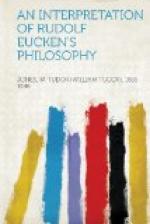* * * * *
CHAPTER VII [p.119]
RELIGION AND ART
Eucken has written less on this subject than on any of those which constitute the headings of the chapters of this book. But he has treated art in precisely the same manner as he has treated all other important problems: he has shown that no great art is possible unless it is rooted in a creativeness which is spiritual. In his Main Currents of Modern Thought we get an instructive account of art and its relation to morality. His account of the development of art in modern times, from the Renaissance to the present day, shows the ebb and flow of the conception of the Beautiful. The check which the Renaissance received through the Reformation in relation to art had its good as well as its evil side. Intense scorn arose in the Protestant world for every kind of image and decoration, because these were supposed to posit life on what was purely sensuous and natural, and so bar the way to the Divine. Still, the obstruction [p.120] created by Protestantism in this direction opened a door in quite another direction. Art of a higher kind than picture or statue arose, which was far removed from the sensuous level and which emerged from a deeper soil within the soul. The whole series of musical composers produced by Germany is a proof of this. The period of the Aufklaerung viewed art with scant favour, but with the rise of the New Humanism a change in favour of art took place.
The origin of this change is to be found where one might least expect it—in the soul of the sage of Koenigsberg. Kant’s Critique of Judgment is unanimously allowed to be the greatest book ever produced on the subject. Goethe and Schiller were influenced by it—the latter in a remarkable manner. We find in these writers an effort to unite the Good and the Beautiful. It is impossible to read the poetry of Goethe without finding that great moral problems are imbedded in his conceptions of the Beautiful. His poetry is an attempt to bridge the chasm between the external world and the soul. His nature was too deep to remain satisfied with the mere impressions of the senses. The union of the world without with the world within gave him a view of the universe and of human life full of originality and suggestiveness.




